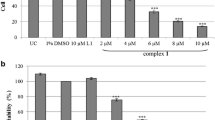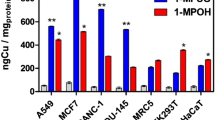Abstract
First generation silver(I) phosphines have garnered much interest due to their vast structural diversity and promising anticancer activity. Increasing incidences of cancer, side-effects to chemotherapeutic agents and redevelopment of tumors due to resistance prompts the exploration of alternative compounds showing anticancer activity. This study revealed the effective induction of cell death by a silver(I) thiocyanate 4-methoxyphenyl phosphine complex in a malignant esophageal cell line. Apoptotic cell death was confirmed in treated cells. Moreover, mitochondrial targeting via the intrinsic cell death pathway was evident due to low levels of ATP, altered ROS activity, mitochondrial membrane depolarization, cytochrome c release and caspase-9 cleavage. The complex displayed low cytotoxicity towards two human non-malignant, skin and kidney, cell lines. The findings reported herein give further insight into the selective targeting of silver(I) phosphines and support our belief that this complex shows great promise as an effective chemotherapeutic drug.










Similar content being viewed by others
Abbreviations
- Δψm :
-
Mitochondrial membrane potential
- Apaf-1:
-
Apoptosis protease activating factor-1
- CCCP:
-
Carbonyl cyanide 3-chlorophenylhydrazone
- CDDP:
-
Cis-diamine-dichloro platinum (cisplatin)
- Cyt c :
-
Cytochrome c
- DMSO:
-
Dimethyl sulfoxide
- FITC:
-
Fluorescein isothiocyanate
- IC50 :
-
Half maximal inhibitory concentration
- LMS:
-
Leiomyosarcoma cells
- MOMP:
-
Mitochondrial outer membrane permeabilization
- PARP:
-
Poly (ADP-ribose) polymerase
- PI:
-
Propidium iodide
- PS:
-
Phosphatidylserine
- ROS:
-
Reactive oxygen species
References
Acs AC (2010) Cancer Facts & Figures 2010. American Cancer Society, Atlanta. http://www.cancer.org/research/cancer-facts-statistics/all-cancer-facts-figures/cancer-facts-figures-2010.html. Accessed May 18, 2017
Berners-Price SJ, Sadler PJ (1988) Phosphines and metal phosphine complexes: relationship of chemistry to anticancer and other biological activity. Struct Bond 70:27–102
Berners-Price SJ, Mirabelli CK, Johnson RK, Mattern MR, McCabe FL, Faucette LF, Sung CM, Mong SM, Sadler PJ, Crooke ST (1986) In vivo antitumor activity and in vitro cytotoxic properties of bis [1, 2-bis (diphenylphosphino) ethane] gold (I) chloride. Cancer Res 46(11):5486–5493
Borst P, Rottenberg S, Jonkers J (2008) How do real tumors become resistant to cisplatin? Cell Cycle 7(10):1353–1359
Brandys MC, Puddephatt RJ (2002) Polymeric complexes of silver(I) with diphosphine ligands: self-assembly of a puckered sheet network structure. J Am Chem Soc 124(15):3946–3950
Cain K, Bratton SB, Cohen GM (2002) The Apaf-1 apoptosome: a large caspase-activating complex. Biochimie 84:203–214
Engelbrecht Z, Potgieter K, Mpela Z, Malgas-Enus R, Meijboom R, Cronjé MJ (2017) A comparison of the toxicity of mono, bis, tris and tetrakis phosphino silver complexes on SNO esophageal cancer cells. Anticancer Agents Med Chem. doi:https://doi.org/10.2174/1871520617666170522123742
Ferlay J, Shin HR, Bray F, Forman D, Mathers C, Parkin DM (2010) Estimates of worldwide burden of cancer in 2008: GLOBOCAN 2008. Int J Cancer 127(12):2893–2917
Ferreira E, Munyaneza A, Omondi B, Meijboom R, Cronjé MJ (2015) The effect of 1:2 Ag (I) thiocyanate complexes in MCF-7 breast cancer cells. Biometals 28(4):765–781
Gakunga R, Parkin DM (2015) Cancer registries in Africa 2014: a survey of operational features and uses in cancer control planning. Int J Cancer 137(9):2045–2052
Human Z, Munyaneza A, Omondi B, Meijboom R, Cronjé MJ (2015) The induction of cell death by phosphine silver(I) thiocyanate complexes in SNO-esophageal cancer cells. Biometals 28(1):219–228
Human-Engelbrecht Z, Meijboom R, Cronjé MJ (2017) Apoptosis-inducing ability of silver(I) cyanide-phosphines useful for anti-cancer studies. Cytotechnology 69(4):591–600
Johnstone RW, Lowe SW, Ruefli AA (2002) Apoptosis: a link between cancer genetics and chemotherapy. Cell 108:153–164
Kelland LR, Mistry P, Abel G, Loh SY, O’Neil CF, Murrer BA, Harrap KR (1992) Mechanism-related circumvention of acquired cis-diamminedichloroplatinum (II) resistance using two pairs of human ovarian carcinoma cell lines by ammine/amine platinum (IV) dicarboxylates. Cancer Res 52:3857–3864
Kerr JFR, Wyllie AH, Currie AR (1972) Apoptosis: a basic biological phenomenon with wide-ranging implications in tissue kinetics. Br J Cancer 26:239–257
Kriel FH, Coates J (2012) Synthesis and antitumour activity of gold(I) and silver(I) complexes of hydrazine-bridged diphosphine ligands. S Afr J Chem 65:271–279
Lee KB, Wang D, Lippard SJ, Sharp PA (2002) Transcription-coupled and DNA damage-dependent ubiquitination of RNA polymerase II in vitro. Proc Natl Acad Sci 99:4239–4244
Li P, Nijhawan D, Budihardjo I, Srinivasula SM, Ahmad M, Alnemri ES, Wang X (1997) Cytochrome c and dATP-dependent formation of Apaf-1/caspase-9 complex initiates an apoptotic protease cascade. Cell 91:479–489
Liu JJ, Galettis P, Farr A, Maharaj L, Samarasinha H, McGechan A, Baguley BC, Bowen RJ, Berners-Price SJ, McKeage MJ (2008) In vitro antitumour and hepatotoxicity profiles of Au(I) and Ag (I) bidentate pyridyl phosphine complexes and relationships to cellular uptake. J Inorg Biochem 102:303–310
McKeage MJ, Papathanasiou P, Salem G, Sjaarda A, Swiegers GF, Waring P, Wild SB (1998) Antitumor activity of gold(I), silver(I) and copper(I) complexes containing chiral tertiary phosphines. Met Based Drugs 5(4):217–223
McKeage MJ, Berners-Price SJ, Galettis P, Bowen RJ, Brouwer W, Ding L, Zhuang L, Baguley BC (2000) Role of lipophilicity in determining cellular uptake and antitumour activity of gold phosphine complexes. Cancer Chemother Pharmacol 46(5):343–350
Murphy MP (2009) How mitochondria produce reactive oxygen species. Biochem J 417(1):1–13
Ott M, Robertson JD, Gogvadze V, Zhivotovsky B, Orrenius S (2002) Cytochrome c release from mitochondria proceeds by a two-step process. Proc Natl Acad Sci 99(3):1259–1263
Potgieter K, Cronjé MJ, Meijboom R (2015) Synthesis and characterisation of silver(I) benzyldiphenylphosphine complexes: towards the biological evaluation on SNO cells. Inorg Chim Acta 437:195–200
Poyraz M, Banti CN, Kourkoumelis N, Dokorou V, Manos MJ, Simčič M, Golič-Grdadolnik S, Mavromoustakos T, Giannoulis AD, Verginadis II, Charalabopoulos K, Hadjikakou SK (2011) Synthesis, structural characterization and biological studies of novel mixed ligand Ag (I) complexes with triphenylphosphine and aspirin or salicylic acid. Inorg Chim Acta 375(1):114–121
Rackham O, Nichols SJ, Leedman PJ, Berners-Price SJ, Filipovska A (2007) A gold (I) phosphine complex selectively induces apoptosis in breast cancer cells: implications for anticancer therapeutics targeted to mitochondria. Biochem Pharmacol 74(7):992–1002
Rafique S, Idrees M, Nasim A, Akbar H, Athar A (2010) Transition metal complexes as potential therapeutic agents. Biotechnol Mol Biol Rev 5:38–45
Riedl SJ, Shi Y (2004) Molecular mechanisms of caspase regulation during apoptosis. Mol Cell Biol 5:897–907
Rodriguez J, Lazebnik Y (1999) Caspase-9 and APAF-1 form an active holoenzyme. Genes Dev 13:3179–3184
Ross MF, Kelso GF, Blaikie FH, James AM, Cochemé HM, Filipovska A, Da Ros T, Hurd TR, Smith RA, Murphy MP (2005) Lipophilic triphenylphosphonium cations as tools in mitochondrial bioenergetics and free radical biology. Biochemistry 70(2):222–230
Segapelo TV, Guzei IA, Spencer LC, Van Zyl WE, Darkwa J (2009) Pyrazolylmethyl) pyridine platinum (II) and gold (III) complexes: synthesis, structures and evaluation as anticancer agents. Inorg Chim Acta 2:3314–3324
Sylla BS, Wild CP (2012) A million Africans a year dying from cancer by 2030: what can cancer research and control offer to the continent? Int J Cancer 130(2):245–250
Thati B, Noble A, Creaven BS, Walsh M, McCann M, Devereux M, Kavanagh K, Egan DA (2009) Role of cell cycle events and apoptosis in mediating the anti-cancer activity of a silver(I) complex of 4-hydroxy-3-nitro-coumarin-bis (phenanthroline) in human malignant cancer cells. Eur J Pharmacol 302:203–214
Vineis P, Wild CP (2014) Global cancer patterns: causes and prevention. Lancet 383(9916):549–557
Yilmaz VT, Gocmen E, Icsel C, Cengiz M, Susluer SY, Buyukgungor O (2014) Synthesis, crystal structures, in vitro DNA binding, antibacterial and cytotoxic activities of new di-and polynuclear silver(I) saccharinate complexes with tertiary monophosphanes. J Photochem Photobiol, B 131:31–42
Zimmermann KC, Bonzon CC, Green DR (2001) The machinery of programmed cell death. Pharmacol Ther 92:57–70
Zou H, Li Y, Liu X, Wang X (1999) An APAF-1· cytochrome c multimeric complex is a functional apoptosome that activates procaspase-9. J Biol Chem 274:11549–11556
Acknowledgments
The authors gratefully acknowledge financial assistance from the University of Johannesburg. The Spectrum facility at the University of Johannesburg is acknowledged for the use of the NMR spectrometer and FACSAria flow cytometer.
Author information
Authors and Affiliations
Corresponding authors
Rights and permissions
About this article
Cite this article
Engelbrecht, Z., Meijboom, R. & Cronjé, M.J. The ability of silver(I) thiocyanate 4-methoxyphenyl phosphine to induce apoptotic cell death in esophageal cancer cells is correlated to mitochondrial perturbations. Biometals 31, 189–202 (2018). https://doi.org/10.1007/s10534-017-0051-9
Received:
Accepted:
Published:
Issue Date:
DOI: https://doi.org/10.1007/s10534-017-0051-9




